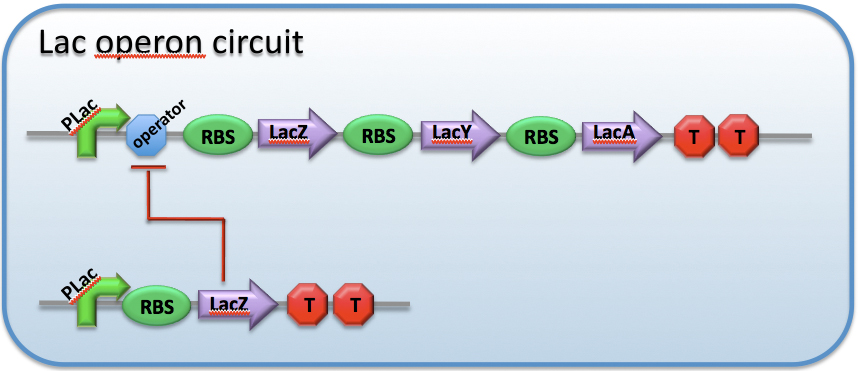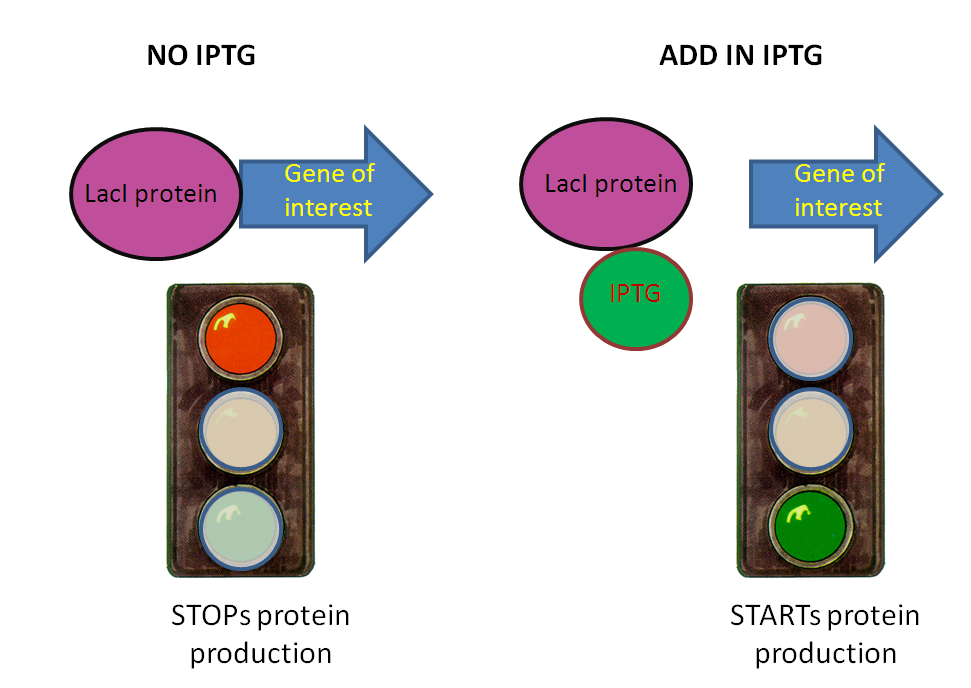Team:Imperial College London/Temporal Control/Chemical Induction
From 2009.igem.org
(→The Lac operon) |
(→Animated explanation) |
||
| Line 23: | Line 23: | ||
==Animated explanation== | ==Animated explanation== | ||
<html> | <html> | ||
| + | <script language="javascript"> | ||
| + | if (AC_FL_RunContent == 0) { | ||
| + | alert("This page requires AC_RunActiveContent.js."); | ||
| + | } else { | ||
| + | AC_FL_RunContent( | ||
| + | 'codebase', 'http://download.macromedia.com/pub/shockwave/cabs/flash/swflash.cab#version=8,0,0,0', | ||
| + | 'width', '552', | ||
| + | 'height', '460', | ||
| + | 'src', 'lacoperon', | ||
| + | 'quality', 'high', | ||
| + | 'pluginspage', 'http://www.macromedia.com/go/getflashplayer', | ||
| + | 'align', 'middle', | ||
| + | 'play', 'true', | ||
| + | 'loop', 'true', | ||
| + | 'scale', 'showall', | ||
| + | 'wmode', 'window', | ||
| + | 'devicefont', 'false', | ||
| + | 'id', 'flashanimation', | ||
| + | 'bgcolor', '#ffffff', | ||
| + | 'name', 'flashanimation', | ||
| + | 'menu', 'true', | ||
| + | 'allowFullScreen', 'false', | ||
| + | 'allowScriptAccess','sameDomain', | ||
| + | 'movie', 'lacoperon', | ||
| + | 'salign', '' | ||
| + | ); //end AC code | ||
| + | } | ||
| + | </script> | ||
| + | |||
<object classid="clsid:d27cdb6e-ae6d-11cf-96b8-444553540000" codebase="http://download.macromedia.com/pub/shockwave/cabs/flash/swflash.cab#version=8,0,0,0" WIDTH="552" HEIGHT="460" id="flashanimation" align="middle"> | <object classid="clsid:d27cdb6e-ae6d-11cf-96b8-444553540000" codebase="http://download.macromedia.com/pub/shockwave/cabs/flash/swflash.cab#version=8,0,0,0" WIDTH="552" HEIGHT="460" id="flashanimation" align="middle"> | ||
<param name="allowScriptAccess" value="sameDomain" /> | <param name="allowScriptAccess" value="sameDomain" /> | ||
Revision as of 22:54, 11 October 2009

Contents |
Chemical Induction
From the Module 1 genetic circuit, in the absence of IPTG in the system, the LacI repressor inhibits production of the protein of interest. When IPTG is added in we start the production of the drug of interest:
In a batch culture system, a defined volume of media is innoculated with a small number of cells. If the cells are being used for protein production, it is vital that synthesis is initiated at the right time. The optimum time for protein production is when there are a large number of rapidly dividing cells in a nutrient rich media.
In our system, the protein of interest is synthesised at the start of the production process in a phase known as Module 1 . Importantly, the time at which Module 1 starts is controlled by the addition of a chemical inducer called IPTG. This means that Module 1 can be initiated when there is the optimum ratio of cells to remaining nutrients.
Induction with IPTG
IPTG is an allolactose analogue. Allolactose is the lactose metabolite that triggers the transcription of the lactose operon in natural systems. Allolactose and IPTG activate transcription of the lac operon by binding to the LacI protein. When such binding occurs, the LacI protein changes confirmation, which renders it unable to bind to the operator region thus allowing the RNA polymerase to continue reading beyond the operator and transcribe the downstream genes.
The Lac operon
 The lac operon is responsible for transport and metabolism of lactose in E-coli, and has the following architecture:
The lacI gene codes for the LacI protein, which inhibits transcription of the genes downstream by binding to the operator region (po). This inhibition is effective because the RNA polymerase is forced to drop off the DNA template when encountering a bound operator region.
LacZ encodes the enzyme β-galactosidase responsible for the degradation of β-galactosides. Since lactose is a β-galactoside, the enzyme will degrade lactose into galactose and glucose. This gene is sufficient to degrade lactose.
LacY encodes for a permease located to the outer membrane, thus ensuring the transport of lactose into the cell. This is a key element of the lactose operon as it acts as a feedback mechanism in the genetic circuitry. In fact, when lactose is present, it stimulates the production of large amounts of permease thus acting as positive feedback.
The LacA protein encodes β-galactoside transacetylase. The exact function of this protein in the lac system has not yet been determined.
The lac operon is responsible for transport and metabolism of lactose in E-coli, and has the following architecture:
The lacI gene codes for the LacI protein, which inhibits transcription of the genes downstream by binding to the operator region (po). This inhibition is effective because the RNA polymerase is forced to drop off the DNA template when encountering a bound operator region.
LacZ encodes the enzyme β-galactosidase responsible for the degradation of β-galactosides. Since lactose is a β-galactoside, the enzyme will degrade lactose into galactose and glucose. This gene is sufficient to degrade lactose.
LacY encodes for a permease located to the outer membrane, thus ensuring the transport of lactose into the cell. This is a key element of the lactose operon as it acts as a feedback mechanism in the genetic circuitry. In fact, when lactose is present, it stimulates the production of large amounts of permease thus acting as positive feedback.
The LacA protein encodes β-galactoside transacetylase. The exact function of this protein in the lac system has not yet been determined.
Animated explanation
Temporal Control: Chemical Induction






 "
"




